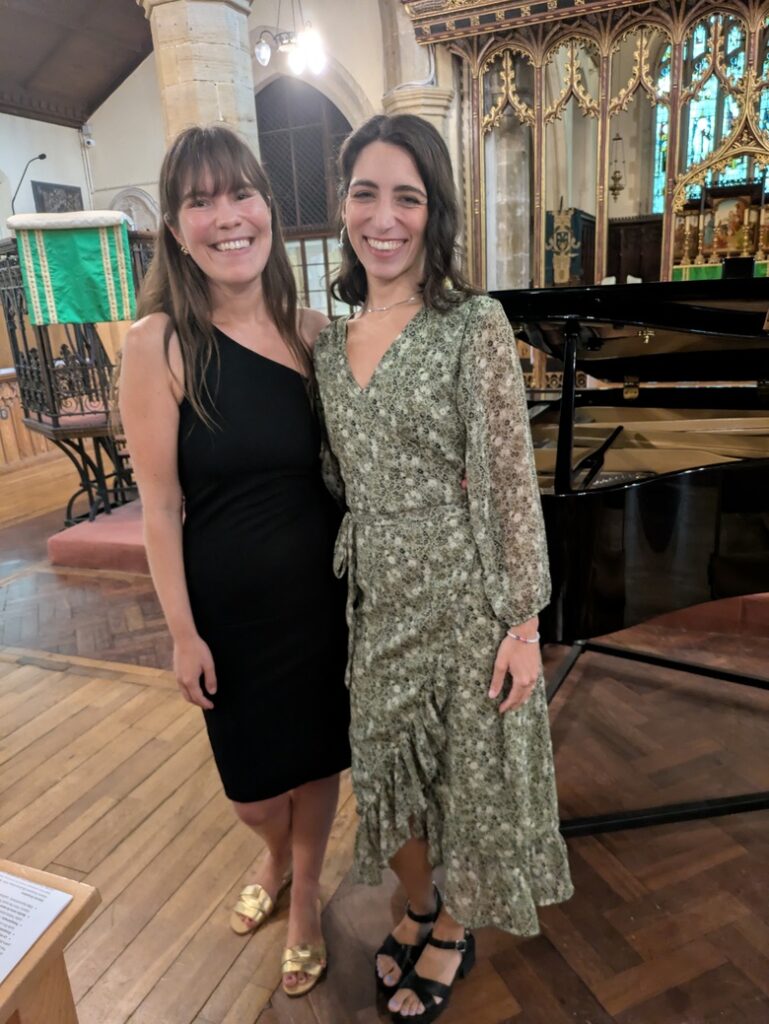Review by Simon Jenner, July 23 2025
St Nicholas has produced a string of blindingly good recitals over the past month. And you can catch these soloists again at St Luke’s on Friday. Argentinians soprano Mercedes Gancedo and pianist Quimey Urquiaga give a unique recital of two great Argentinian composers: Carlos Guastavino and Alberto Ginastera. Because Gancedo was feeling a little under par (you’d not have guessed it and she refused to cancel) the programme shifted from that advertised.
Full of motor rhythms and exuberant drive somewhere echoing Brazilian Heitor Villa-Lobos, Alberto Ginastera (1916-83) known for his orchestral music is here represented by piano and songs too.
Some of us know Carlos Guastavino (1912-2000) Argentine composer and pianist ‘known for his lyrical, romantic style rooted in Argentine folk music. Often called “the Schubert of the Pampas,” he composed over 500 works, including songs, piano pieces, and chamber music.’
There’s a three-CD piano music survey by Martin Jones, and a two-piano work championed by Martha Argerich at her Lugano Festival in 2005. He’s represented here by his songs (Bernarda Fink profiled nine of them alongside Ginastera in a recital mainly of Spaniard Granados, and that’s all most of us know).
First off a few Guastavino piano solos, lyrical and flecked with a folk-tang a long way from the folk music of say Bartok, but you certainly receive the flavour of what we know from the songs too. Here his ‘Cantos populaires’ Nos 1 and 7 respond to that inflected world. The third piece, the ‘Bailecito‘ is more romantic and extended. It’s wonderful to hear them here: a world opens up.
We were then treated to a series of Ginastera piano works not originally planned at this stage. Ginastera’s Op 2 from 1937 when e was just 21 Tres Danzas Argentinas: 1- danza del viejo boyero (Dance of the Old Herdsman), a rhythmically ebullient piece, but sober too, reflecting a kind of 2- danza de la moza donosa or ‘Dance of the delightful maiden’ is quite close to Guastavino: refracting lyrical regret in a more traditional manner Ginastera left behind. That doesn’t detract from its beauty (both Barenboim and Lang Lang have recorded it). 3- danza del gaucho matrero or ‘Dance of the cheeky gaucho’ finds Ginastera in command of a mature voice – one that fed straight into his 1941 ballet Estancia that made his name. Urquiaga is consummate, a virtuoso I’d love to hear in a full programme.
Gancedo was slightly indisposed but you’d not think that. Guastavino’s song ‘La rosa y el sauce’, or ‘The rose and the willow’ is a plangent love song from 1952 full of soaring regret. It’s filled by a gentler less voluble work. ‘Encantamiento’, or ‘Enchantment’ from Six Lullabies (1961) with quiet rippling accompaniment. We then we’re tested to ‘Bonita rama de sauce’, or ‘Beautiful willow song’ from 1967 radiant with joy and summer relaxation.
Gancedo dropped one item and added ‘Pueblito mi pueblo,’ ‘’My small town’ might seem a nostalgic slow and rapt meditation on the kind of feeling you get from some Schumann right through to early Tracey Thorn in ‘Small Town Girl’; though without foreboding or a sense of being overwhelmed. But it’s more: the Pueblo people were to an extent marginalised and Ginastera’s Marxist sympathies are drawn in, in a whisper. This is a quiet celebration and Gancedo projects her voice into the middle distance, a beautiful haze control of evocation.
‘Aromito flor de tusca’ or ‘Little flower song’ is similarly unscheduled and delightful in its perky brevity: a tiny melodic gem. ‘Canción al árbol del olvido‘ or ‘Under the trees’ is by contrast a swoopingly romantic nostalgia song. It arrives with an insistent slow habanera rhythm in the piano where the soprano line soars with slow rapt delivery, wrenched with sexual longing. Despite her slight soreness Gancedo delivers with a forceful climax. You’d never guess anywhere she was under vocal pressure.
Finally ‘Cita‘ or ‘Appointment’ (perhaps ‘Tryst’ might be more precise) published in 1998 two years before Guastavino’s death, is one of those trysting classics where clandestine lovers meet. The girl anticipating rapture with a rippling quiet rhythm; almost fluvial as the warm rapt tones of the young woman float over it. Gancedo moves to the audience front row to deliver this with an enchanted intimacy.
A treasurable gem of a recital. But remember you can catch them on Friday at St Luke’s Brighton. Do go.




